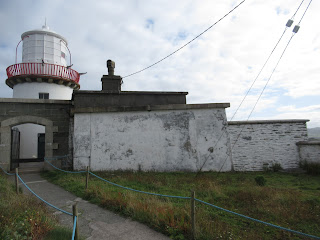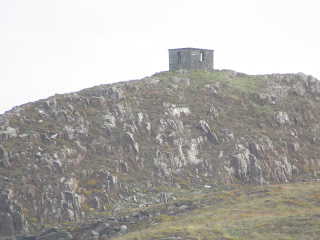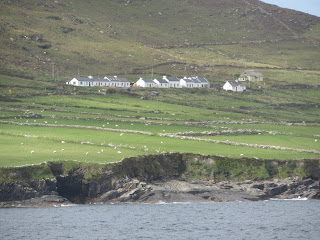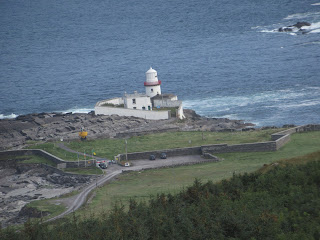After finally dyeing my hair an Irish red (!), we headed out to explore tiny Valentia Island where we were staying before needing to go over to Portmagee on the mainland for our much anticipated boat trip to, and climb up, Skellig Michael that afternoon. We came close but weren't able to actually reach a lighthouse the day before while driving on the Ring of Kerry so the thought of seeing the one on Valentia Island was all the more appealing.
Me and my new do by the lighthouse! Steven loves it when it's really red like this but I prefer it when the color tones down in a couple of weeks - always a fine line with looking the perfect shade in my opinion before the gray roots come through!
This was a harbor lighthouse to guide vessels from the sea and lead them through the northern entrance into Valentia Harbor. The light was originally applied for in March of 1828 and, when the tower opened in 1841, its light with 2,000 'candlepower' could be seen from twelve miles away in clear weather,
After the station was converted to automatic in 1947, a significant improvement with the light came with electrification in 1966 when the candlepower was increased to 34,500. In 2016, the actual light was replaced with a new light emitting LED powered by 24V batteries. If the other worker had shown up for work, we could have climbed up the lighthouse but we were in a time crunch to get back to Portmagee so wouldn't have had time so it didn't matter.
On the 63-meter summit of the western end of the island was a block hut known as Pilot's Lookout which was used in the 19th and early 20th centuries to spot ships coming into Dingle Bay that may have required piloting into Valentia Harbor.
The quarry was central to the development of Knightstown village. At its height, it employed 400 people and, significantly, remained open during the Great Potato Famine which devastated Ireland from 1845-1850. After competition from cheaper Welsh slate, it was closed for a number of years in the 1880s which left many people unemployed and destitute. The quarry reopened from 1900-1911 in an attempt to give islanders employment and again in the 1990s but was then closed again.
The pretty purple flower looked so out of place amid the somber gray slate.
Although flagstones and slates were the main products of the Valentia quarry, more unusual items included altars, tombstones, sundials and garden seats. The surviving chimney was the only remaining section of the machine house where a steam engine powered saws for shaping the flagstone. High up in the quarry side was the Our Lady of the Grotto placed there in 1954 in memory of the Very Rev. James Enright of Valentia.
There were two types of heather, each growing up to 50 cm high, on Geokaun: Bell and Ling and both were in full bloom although I couldn't tell the difference! Heather is eaten by livestock until it gets old and woody.
IF we peered really closely and used some imagination, we could almost spot the southernmost of the Western Blasket Islands that we also hoped to land on in a couple of days. The 199-acre island had an early Christian monastic settlement and was intermittently occupied by a few families during the 19th and 20th centuries. A lighthouse on another of the Blasket islands was built in 1870. When the rock was fogbound, seafarers relied on the sound of the foghorn which could be heard for several miles.
During the Irish 1916 Easter rebellion, a German ship bringing 16,000 arms to the rebels sheltered under the lighthouse during a massive Holy Week storm.
Steven and I were pretty sure that someone had been cutting away the peat from the bogs that surrounded this part of the mountain. Peat had been the source of heat and cooking fuel for centuries for Irish people but its removal is now frowned upon for environmental reasons.
The greatest global communication and engineering achievement of he 19th century was the laying of the first transatlantic cable between Newfoundland in Canada and Knightstown here on Valentia Island in 1858. The 2,000 miles of cable was divided between the HMS Agamemnon and the USS Niagara. They each sailed to the mid Atlantic and spliced the cable together. The Agamemnon then sailed to Valentia, and the Niagara to Canada (although technically Newfoundland wasn't part of Canada until 1949!), reaching their destinations on August 5th, 1858. When the first official message was sent on the 16th, it reduced communication time from days to minutes.
Trained telegraphers came from England and lived in company houses built near the Cable Station at Knightstown, the capital of Valentia. They brought great prosperity to the island at a time of great poverty in Ireland. Knightstown, where we were staying for two nights, began a hub for international communications for the next 100 years.
The Valentia Island Lighthouse at the rocky and windswept Cromwell's Point was our destination. Steven and I often laugh at how incredibly lucky we are in terms of things on our trips working so smoothly more often than not. One instance was a couple of days previously when we just happened to drive into the Kissane Sheep Farm south of Killarney to enquire about a sheep dog herding exhibition and and found out the next and only one one that day would be in just five minutes! We had the same 'luck of the Irish' or whatever you might want to call it when we happened to arrive at the lighthouse one minute after the guard/ticket taker arrived. Then he said the other employee hadn't showed up so we only had to pay the children's price as there was no one to give us a guided tour!
The star-shaped Fleetwood Fort was built in 1653 to guard the entrance to Valentia Harbor and was manned by a garrison of 40 soldiers until it was decommissioned in 1669. In 1841, the lighthouse was built inside the fort walls. The oil lamp with a fixed white light that flashed every two seconds and had a range of 12 miles was maintained by a single keeper who lived there with his family. The Lightkeeper's Dwelling was an asymmetrical stone and concrete, two-story building erected in 1910. The last lightkeeper and his family left in 1947 when the lighthouse was automated.
The Blockhouse was a strong masonry fortification with two-meter thick walls. Loopholes aka gun ports in the side walls helped defend the Blockhouse from island attackers. Also inside the fortifications were the Gunnery, Gunpowder Magazine and a vaulted room that likely served as a storage room for cannonballs, gunpowder and ammunition.
I had known that a 'magazine' referred to an item or place where ammunition or other explosive material was stored. What I hadn't realized before was that it came from the Arabic word 'makhazin' meaning gunpowder magazine or storeroom. Until gunpowder was superseded, it was an universal explosion used in the military and for civilian engineering as both applications required storage magazines. In the early history of artillery as part of setting up an artillery battle, a designated place would be used to store the ready ammunition to avoid catastrophic explosions.
The lighthouse was operated by the Commissioner of Irish Lights for the protection of all mariners around the coast of Ireland. The Safety of Life at Sea requires all maritime countries to provide Aids to Navigation to internationally agreed standards. That was why there were over 70 lighthouses, hundreds of buoys and electronic and radio aids for general shipping to fulfill the country's obligation. In addition, thousands more are audited for local users to provide an essential marine safety service protecting lives, property, commerce and the marine environment.
From the lighthouse, we could spot Beginish Island (from the Irish meaning 'small island'), a currently uninhabited island with other small islands surrounding it. One of them, Church Island, was notable for having the remains of a monastic settlement with an oratory or small chapel and holy well and shrine. Beginish had numerous archaeological sites including a Viking settlement occupied between the 10th and 12th centuries which consisted of a circular stone dwelling, outhouse and a midden which was a mound consisting of shells of edible mollusks and other refuse which indicated it was the site of prehistoric human habitation.
As the lighthouse was surrounded by the old Fleetwood Fort, artillery canons were in place.
Piles of slate from the nearby slate quarry:
From the shore by the lighthouse we could see the ever so tiny settlement in Dohilla which was comprised of a series of miners' cottages on White Street, so called because of the whitewash on the homes. The street of houses was built to accommodate the miners who came from Wales to manage the opening of the Slate Quarry in 1816. The street was unique because all the roofs were slated, all were painted white and there was no fences between the houses and the road. While the location looked extremely exposed, locals said, "You could carry a candle to the cowhouse, no matter the stormy night."
A short drive away was the Slate Quarry which began operations in 1816 under the direction of the Knight of Kerry by one of of the principal landowners on Valentia Island. Experts from Wales were brought in to teach the miners slate-making techniques. The miners worked from 7 am to 6 pm and were paid 2 shillings and 6 pence per day, which was double the pay of mainland workers! On their way to school, the children brought bottles of tea to their fathers working in the mine. The bottles were kept warm as they were wrapped in socks.
The pretty purple flower looked so out of place amid the somber gray slate.
At its peak, Valentia slate was famous worldwide. It was exported and used to roof the Paris Opera House, the British Houses of Parliament at Westminster that we hoped to see in early October), and a number of British railway stations. The British Records Office in London had 26 miles of Valentia slate shelving. Slate was also used for the tops of billiard tables including ones made for the Duke of Wellington and Queen Victoria.
As we climbed higher and higher in the hills, we had some pretty marvelous views of the bay and of the lighthouse again.
We hightailed it then over to the mainland and the tiny harbor town of Portmagee for our long anticipated boat ride to and then the landing trip on Skellig Michael. You can read all about that in the next post.
Later in the day we headed to Geokaun Mountain and Fogher Cliffs back on Valentia Island. As the mountain was the highest point on the island, we had glorious 360 degree views over the island and also out to the Skelligs we'd tried so hard to land on earlier that day.
Golden colored gorse covered the hills as far as we could see just as it had on Dursey Island on the Beara Peninsula a couple of days ago. Two types of gorse grew to two meters high in acid soils in this part of Ireland, Common and Western. We were lucky to be around when the latter ones were blooming so prolifically!
There were two types of heather, each growing up to 50 cm high, on Geokaun: Bell and Ling and both were in full bloom although I couldn't tell the difference! Heather is eaten by livestock until it gets old and woody.
One of
the joys driving the country lanes the last couple of weeks has been seeing the
flaming fuchsia coloring the hedgerows. The deciduous shrubs reach up to
1.5 meters high and favor coastal locations and rocky ground, thriving on high
rainfall and high humidity. I read that they "look like a ballerina with a
crimson skirt, purple petticoat and long legs." You can judge for yourself if you think the description is apt from this photo I took on Valentia!
As we continued hiking the trails around the mountain, we again caught sight in the distance of the island's lighthouse that we'd toured that morning!
Steven and I were pretty sure that someone had been cutting away the peat from the bogs that surrounded this part of the mountain. Peat had been the source of heat and cooking fuel for centuries for Irish people but its removal is now frowned upon for environmental reasons.
In the distance we could see the coastguard radio station that has been responsible for saving lives in the Atlantic since 1914. In 1902, a radio station was set up in West Cork but it was moved to Valentia four years later. A new one was built in 1914 at the beginning of WW I and it was operated by British navy personnel until 1921 and then by the British Post Office until 1950. It has been run since then by various Irish government departments.
It now also operates as a marine rescue center and coordinates search and rescue at sea. The station transmits safety notices, navigation warnings and weather forecasts daily. Valentia radio Station is now part of the Irish coast Guard Service.
When deciding where to stay months ago for our trip to Skellig Michael, Steven and I had just happened to choose to stay on Valentia Island rather than in Portmagee on the mainland even though the latter may have been more convenient. As it turned out, we both agreed our choice had turned out far better than we could ever have expected as there was lots to see of interest to us on the tiny island.
Next post: Landing cruise to Skellig Michael - yes or no?
Posted on September 25th, 2019, from Conwy, Wales, coincidentally, the heart of the country's slate mining!












































Annie, I love your red hair !!!!
ReplyDeleteAnd Valentia Island is a winner in my books.. thanks for introducing it to us.
xo
Lina - You're such a sweetheart commenting positively on my red hair. I'm at the same point having to do my 'do' again!
ReplyDelete